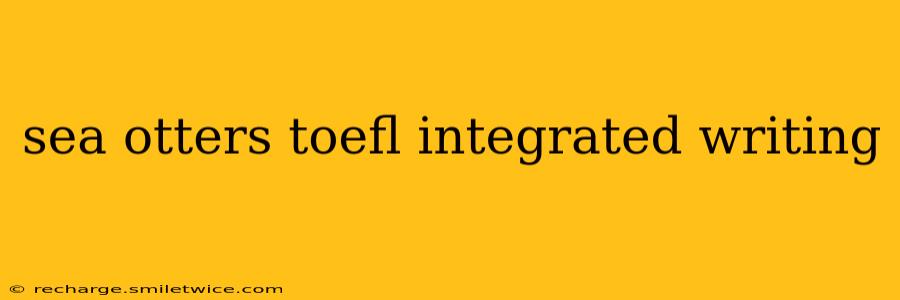Sea Otters: A TOEFL Integrated Writing Task Deep Dive
The TOEFL Integrated Writing section often features passages about diverse topics, testing your ability to synthesize information from multiple sources. Sea otters, with their unique adaptations and ecological importance, frequently appear in these tasks. This post will delve into the common themes surrounding sea otters in TOEFL Integrated Writing, providing you with strategies to tackle such questions effectively. We'll examine typical question structures and explore how to integrate information from lectures and readings to craft a compelling response.
What are the key characteristics of sea otters?
Sea otters are fascinating marine mammals known for several distinctive characteristics. They are the smallest marine mammals in North America, possessing remarkably dense fur—a crucial adaptation for survival in frigid waters. Their unique adaptations also include webbed feet for efficient swimming and powerful claws for manipulating food and holding onto kelp forests. Their diet primarily consists of shellfish, sea urchins, and other invertebrates, making them keystone species in their ecosystems.
What role do sea otters play in their ecosystems?
Sea otters are considered keystone species, meaning their presence significantly impacts the biodiversity and health of their environment. Their voracious appetite for sea urchins helps regulate urchin populations. Without sea otters, sea urchin populations can explode, leading to overgrazing of kelp forests. Kelp forests, in turn, provide vital habitats for a wide range of marine life. Thus, the decline of sea otter populations can trigger a cascade effect, ultimately damaging the entire ecosystem's health. This interconnectedness is a crucial aspect often highlighted in TOEFL Integrated Writing tasks related to sea otters.
How are sea otters threatened, and what conservation efforts are underway?
Sadly, sea otters face numerous threats, including habitat loss due to human development, pollution, and entanglement in fishing gear. Oil spills pose a significant danger, damaging their incredibly dense fur which provides insulation. Additionally, predation by larger animals, like orcas, can also impact their populations. Conservation efforts often focus on habitat protection, reducing pollution, and mitigating the impact of human activities on their habitats. Research into the effects of climate change on sea otter populations is also becoming increasingly important. These conservation challenges are often central to integrated writing prompts, demanding your ability to summarize and synthesize information on both threats and solutions.
How do sea otter populations affect kelp forests? (People Also Ask - Google)
As mentioned earlier, sea otters play a critical role in maintaining the health and abundance of kelp forests. Their predation on sea urchins prevents these herbivores from overgrazing the kelp. Without sufficient sea otters, the sea urchin populations boom, leading to the decimation of kelp forests. This, in turn, impacts the biodiversity of the entire ecosystem, highlighting the importance of sea otters as a keystone species.
What are the main differences between sea otters and other marine mammals? (People Also Ask - Google)
While other marine mammals, such as seals and sea lions, also inhabit coastal waters, sea otters possess unique characteristics distinguishing them. Their exceptionally dense fur, crucial for insulation in cold waters, sets them apart. They are also significantly smaller than most other marine mammals. Furthermore, their dietary preferences and keystone role in kelp forest ecosystems further distinguish them within the marine mammal community.
What are the long-term consequences of sea otter population decline? (People Also Ask - Bing)
The long-term consequences of sea otter decline are far-reaching and ecologically devastating. The loss of this keystone species leads to an imbalance in the marine ecosystem. Uncontrolled sea urchin populations devastate kelp forests, affecting numerous other species that rely on these habitats for food and shelter. This ripple effect can ultimately cause biodiversity loss, disrupt food webs, and alter the overall structure and function of the coastal ecosystem.
Mastering the TOEFL Integrated Writing Task:
To excel in this section, focus on:
- Careful reading comprehension: Thoroughly understand both the reading passage and the lecture.
- Note-taking: Jot down key points and supporting details during the listening portion.
- Synthesis: Skillfully combine information from both sources in your response.
- Clarity and organization: Structure your essay logically, using clear topic sentences and transitions.
- Grammar and vocabulary: Demonstrate accurate grammar and a range of sophisticated vocabulary.
By understanding the intricacies of sea otter biology and their ecological importance, and by applying effective test-taking strategies, you can confidently tackle TOEFL Integrated Writing tasks involving these fascinating creatures. Remember to practice regularly with different sample questions to improve your skills and achieve your desired score.
